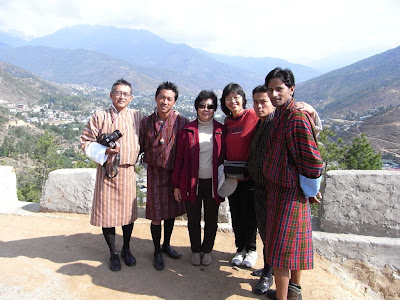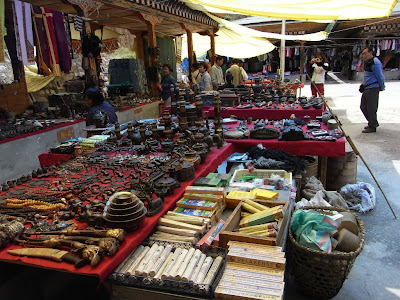The National Memorial Chorten was built in 1974 to honour the memory of the third king, Jigme Dorji Wangchuck. It is also a monument to world peace.
The memorial chorten is one of the most visible religious structures in Thimphu. The paintings and statues inside the monument provide a deep insight into Buddhist philosophy. People are seen circumambulating the chorten, some prostrating.
Mini Zoo
Visited the mini zoo of Bhutan where Takins, the national animal of Bhutan are housed.
Below explained why the animal was chosen as the national animal (extracted from Lonely Planet).
‘The reason for Bhutan selecting the Takin as the national animal is based on both its uniqueness and its strong association with the country's religious history and mythology. According to legend, when the great saint Lama Drukpa Kunley (called "the divine madman") visited Bhutan in the 15th century, a large congregation of devotees gathered around the country to witness his magical powers. The people urged the lama to perform a miracle. However, the saint, in his usual unorthodox and outrageous way, demanded that he first be served a whole cow and a goat for lunch. He devoured these with relish and left only bones. After letting out a large and satisfied burp, he took the goat's head and stuck it onto the bones of the cow. And then with a snap of his fingers, he commanded the strange beast to rise up and graze on the mountainside. To the astonishment of the people the animal arose and ran up to the meadows to graze. This animal came to be known as the dong gyem tsey (takin) and to this day, these animals can be seen grazing on the mountainsides of Bhutan.’
At National Memorial Chorten
 A rare occasion when all members of the group,
A rare occasion when all members of the group,
the leader and the tour guide are in the same photo!

 Prayer wheels play an important role
Prayer wheels play an important role
in the life of Bhutanese people.


 Good road, clear weather, and beautiful scenery
Good road, clear weather, and beautiful scenery
 Stopped here for a good view of Thimphu
Stopped here for a good view of Thimphu
 Takin, the national animal of Bhutan (above and below)
Takin, the national animal of Bhutan (above and below)

 The Butanese way of life is greatly
The Butanese way of life is greatly
influenced by religion. Praying, chanting
and twirling prayer wheels as they walk.
 The young nuns at the nunnery doing
The young nuns at the nunnery doing
their daily chores (above and below)


At the bazaar and Centenary Farmers Market
 Bazaar (above and below)
Bazaar (above and below)

 Red rice (commonly taken in Bhutan)
Red rice (commonly taken in Bhutan)
 Deep-fried rice
Deep-fried rice
 Big chillies – Bhutanese eat chillies
Big chillies – Bhutanese eat chillies
as a vegetable, not as a seasoning!

 A rare occasion when all members of the group,
A rare occasion when all members of the group,the leader and the tour guide are in the same photo!

 Prayer wheels play an important role
Prayer wheels play an important rolein the life of Bhutanese people.


 Good road, clear weather, and beautiful scenery
Good road, clear weather, and beautiful scenery Stopped here for a good view of Thimphu
Stopped here for a good view of Thimphu Takin, the national animal of Bhutan (above and below)
Takin, the national animal of Bhutan (above and below)
 The Butanese way of life is greatly
The Butanese way of life is greatlyinfluenced by religion. Praying, chanting
and twirling prayer wheels as they walk.
 The young nuns at the nunnery doing
The young nuns at the nunnery doingtheir daily chores (above and below)


At the bazaar and Centenary Farmers Market
 Bazaar (above and below)
Bazaar (above and below)
 Red rice (commonly taken in Bhutan)
Red rice (commonly taken in Bhutan) Deep-fried rice
Deep-fried rice Big chillies – Bhutanese eat chillies
Big chillies – Bhutanese eat chilliesas a vegetable, not as a seasoning!

+-+Copy.jpg)

No comments:
Post a Comment